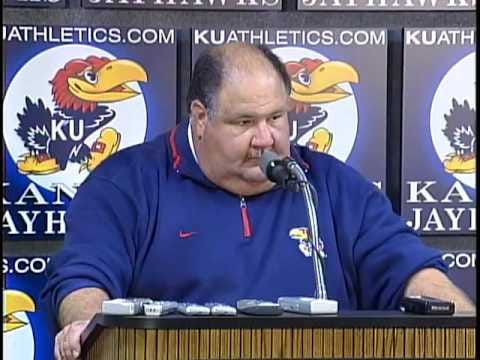Kansas-Texas isn’t a particularly noteworthy college football series on its face. Dominated by the Longhorns for almost its entirety since 1996, the record sits at 17-2 Texas post-World War II.
Conference championship implications rarely ride on a KU-Texas matchup. Hell, in Kansas’ unforgettable 2007 campaign, the programs never played. Ditto 1998, meaning Heisman Trophy winner Ricky Williams had no stats accrued against a lackluster Jayhawks defense to pad his resume.
I associate Kansas and Texas games far more with winter and excellent Big Monday basketball contests; with Kirk Hinrich and TJ Ford captaining the Jayhawks and Longhorns to the 2003 Final Four.
Those games going by the wayside with Texas bound for the SEC, most basketball fans will miss. But football fans?
Sure, there are some noteworthy moments in the Kansas-Texas gridiron series: The Jayhawks’ 24-21, overtime win in November 2016 — the first Kansas victory since 1938 — effectively sealed the fate of coach Charlie Strong.
Another overtime clash in 2021 provided maybe my A-1 favorite example of the positives of Name Image & Likeness legislation, when Kansas hero Jared Casey landed a variety of endorsement deals in the wake of a 57-56 Jayhawks victory.
I’m certainly not opposed to a superstar and future first-round draft pick like Caleb Williams endorsing Dr. Pepper. However, a walk-on who would almost assuredly never sniff the NFL having an opportunity to capitalize on his collegiate stardom is where I see NIL being its most impactful.
Casey’s commercial appeal in 2021 reflects a swiftly and dramatically changing landscape for college football, as did KU and Texas going to one-possession finishes four times from 2016 through that season.
In the 21 years and 13 matchups prior, just twice did the Jayhawks and Longhorns go to one-score decisions. One of those, however, encapsulates the entire loveless marriage-of-convenience that was Texas’ merger with the former Big 8 Conference.
On Nov. 13, 2004, Texas survived a 27-23 scrap in Lawrence. Mark Mangino was in the process of steadily building the long-struggling Jayhawks into contenders. Beating the No. 6-ranked team in the nation would have marked a major milestone in KU’s development.
And, coincidentally, losing would have dropped the Longhorns from the Bowl Championship Series — coincidentally, because Texas’ selection for the Rose Bowl Game over a Cal team that took No. 1 USC to the wire in Los Angeles came with a great deal of controversy.
Mack Brown’s aggressive politicking in college football media for that coveted BCS at-large berth after Texas lost a 12-0 Red River Shootout gained the Longhorns coach immediate infamy out West.
Cal had not played in the Granddaddy Of ‘Em All in nearly a half-century — and still hasn’t an additional 19 years after — and all the conditions were ripe for a classic Pac-10 vs. Big Ten matchup between the Golden Bears and Michigan.
Brown’s politicking — and perhaps more accurately, the advertising dollars attached to pairing the Texas brand with fellow blue-blood Michigan — won out. Less than a month before the BCS matchups were announced, however, the Longhorns stayed alive in a fashion befitting the controversy tied to their Rose Bowl invite.
Kansas had Texas on the ropes, leading 23-13 midway through the fourth quarter. Vince Young rushed for a touchdown with a little more than four minutes remaining to pull the Longhorns to within a field goal.
KU took the ensuing possession and went three-and-out…but only after a long, second-down completion that should have resulted in a fresh set of downs and a running clock was negated on an offensive pass interference penalty that can be most charitably described as questionable.
Texas regained possession and Young threw a game-winning touchdown pass to Tony Jeffrey with 11 seconds remaining, as a Longhorns winning streak that continued until the 2006 season rolled on.
In his fiery postgame presser, Mangino said the push-off as deemed by officials and setting up the decisive drive was a swim move “taught by every offensive coach” in football.
But that was secondary to Mangino’s theory as to why the flag was thrown. He unambiguously credited the penalty to Big 12 officials protecting Texas’ — and, by extension, the conference’s prospects of sending two teams to the BCS.
Mangino’s position could be called conspiratorial. Occam’s Razor begs the question, why even allow a game to get that close if the fix is in?
Blatant intervention on the Longhorns’ behalf is unlikely. But throughout its tenure in the Big 12, there was often a feeling as if Texas brass expected to be kowtowed to — and the league office was more than happy to oblige.
Mangino was hardly the only opposing to rail against officiating in a loss to the Horns. This coming week marks 10 years to the day Texas won at Iowa State in a game with plenty of controversial flags, prompting a postgame eruption from Cyclones coach Paul Rhoads.
And then there was the Longhorn Network. Oh, the Longhorn Network.
Anyone with the slightest beat on college sports’ pulse could have informed both the Big 12 leadership and ESPN executives that a network dedicated to a single program not named Notre Dame would be DOA.
Nevertheless, Texas got its network. In retrospect speaking to the general medium of cable television, Longhorn Network feels analogous to dot com start-ups buying airtime during Super Bowl XXXIV. TV giants were drunk on their own immediate success and spending money without foresight.
More specific to the Big 12, LHN was a stop-gap measure to keep around a partner that never really wanted anything to do with the partnership. And it did nothing to please members of the league responsible for laying the Big 12’s foundation, like Missouri and Colorado.
LHN forced out both longtime Big 8 members, each joining conferences where they never felt like true fits. Missouri makes a boatload in the SEC and Colorado returns to the Big 12 next year, but neither seems all that meaningful given their respective situations. More on that in a moment.
There’s a clear delineation between the Big 8 Conference and the Big 12, which began in 1996. The Big 8 Conference was a terrific league with deep roots dating back to the first decade of the 20th Century.
Programs mentioned above — Kansas, Iowa State and Missouri — that functioned as little more than supporting actors on Texas’ stage were pillars that made the Big 8 possible going back to 1908.
It’s perhaps easy to dismiss the significance of those three programs. Missouri had its impressive peaks, most notably under Dan Devine, but otherwise was an also-ran.
Kansas and Iowa State were never in the same zip code as Texas when it came to football success.
But Nebraska was also in on the ground floor of what would become the Big 8, and boasted a history every bit as impressive as Texas — if not more so. Oklahoma joined post-World War I and built a legacy that stacks up with its counterpart in Austin, and a rivalry against the Longhorns to boot.
Colorado’s football history was spotty. By the time the Big 8 ended with expansion to 12, however, the Buffs had grown into a national powerhouse.
Big 8 football history is special, and that identity ceased to exist in 1996. Texas arrived with all the subtlety and humility of the beer-swilling, pistol-shooting, convertible-driving frat boys from the opening scene of Texas Chainsaw Massacre — frat boys coincidentally driving from Austin to Dallas for the Red River Shootout.
UT now drives its gas-guzzling Cadillac off to the SEC, leaving behind a conference devoid of identity. Prodigal son Colorado comes back to a league it really never should have left next year, but only four of the old Big 8 remains.
Instead, the Buffs join a conference with members in Orlando; Morgantown, West Virginia; and playing as I write this on a Friday night in a game lacking any juice, teams from Cincinnati and Provo, Utah.
Colorado left the vestiges of a Big 8 that often felt more like a continuation of the Southwest Conference and returns to 2000s Conference USA with different branding.
To be sure, no one is likely to cry over Week 5 marking the final matchup between Kansas and Texas for the foreseeable future. But that the series existing at all reflects the long path we’ve taken to get to this point in college football’s landscape makes for an oddly poetic footnote.




